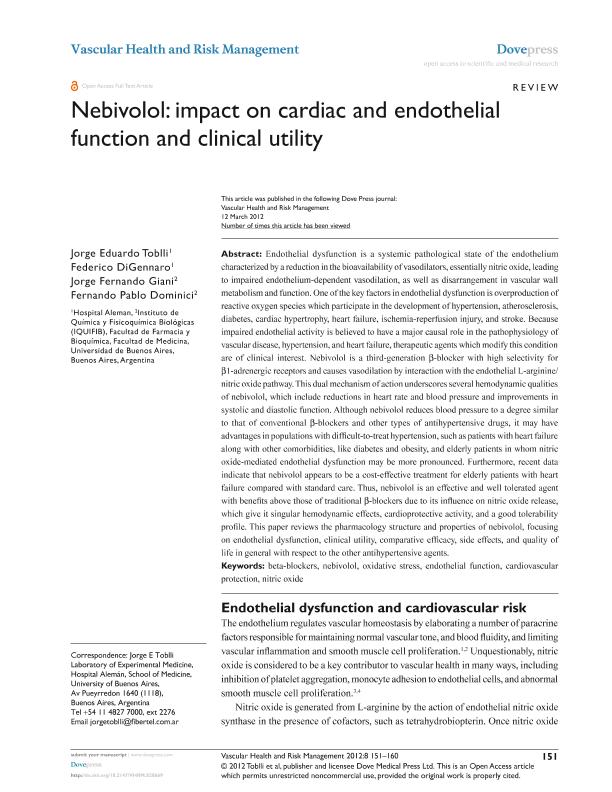Artículo
Nebivolol: impact on cardiac and endothelial function and clinical utility
Fecha de publicación:
03/2012
Editorial:
Dove Medical Press
Revista:
Vascular Health and Risk Management
ISSN:
1176-6344
e-ISSN:
1178-2048
Idioma:
Inglés
Tipo de recurso:
Artículo publicado
Clasificación temática:
Resumen
Endothelial dysfunction is a systemic pathological state of the endothelium characterized by a reduction in the bioavailability of vasodilators, essentially nitric oxide, leading to impaired endothelium-dependent vasodilation, as well as disarrangement in vascular wall metabolism and function. One of the key factors in endothelial dysfunction is overproduction of reactive oxygen species which participate in the development of hypertension, atherosclerosis, diabetes, cardiac hypertrophy, heart failure, ischemia-reperfusion injury, and stroke. Because impaired endothelial activity is believed to have a major causal role in the pathophysiology of vascular disease, hypertension, and heart failure, therapeutic agents which modify this condition are of clinical interest. Nebivolol is a third-generation β-blocker with high selectivity for β1-adrenergic receptors and causes vasodilation by interaction with the endothelial L-arginine/nitric oxide pathway. This dual mechanism of action underscores several hemodynamic qualities of nebivolol, which include reductions in heart rate and blood pressure and improvements in systolic and diastolic function. Although nebivolol reduces blood pressure to a degree similar to that of conventional β-blockers and other types of antihypertensive drugs, it may have advantages in populations with difficult-to-treat hypertension, such as patients with heart failure along with other comorbidities, like diabetes and obesity, and elderly patients in whom nitric oxide-mediated endothelial dysfunction may be more pronounced. Furthermore, recent data indicate that nebivolol appears to be a cost-effective treatment for elderly patients with heart failure compared with standard care. Thus, nebivolol is an effective and well tolerated agent with benefits above those of traditional β-blockers due to its influence on nitric oxide release, which give it singular hemodynamic effects, cardioprotective activity, and a good tolerability profile. This paper reviews the pharmacology structure and properties of nebivolol, focusing on endothelial dysfunction, clinical utility, comparative efficacy, side effects, and quality of life in general with respect to the other antihypertensive agents.
Archivos asociados
Licencia
Identificadores
Colecciones
Articulos(IQUIFIB)
Articulos de INST.DE QUIMICA Y FISICO-QUIMICA BIOLOGICAS "PROF. ALEJANDRO C. PALADINI"
Articulos de INST.DE QUIMICA Y FISICO-QUIMICA BIOLOGICAS "PROF. ALEJANDRO C. PALADINI"
Articulos(SEDE CENTRAL)
Articulos de SEDE CENTRAL
Articulos de SEDE CENTRAL
Citación
Toblli, Jorge Eduardo; DiGennaro, Federico; Giani, Jorge Fernando; Dominici, Fernando Pablo; Nebivolol: impact on cardiac and endothelial function and clinical utility; Dove Medical Press; Vascular Health and Risk Management; 2012; 8; 3-2012; 151-160
Compartir
Altmétricas




